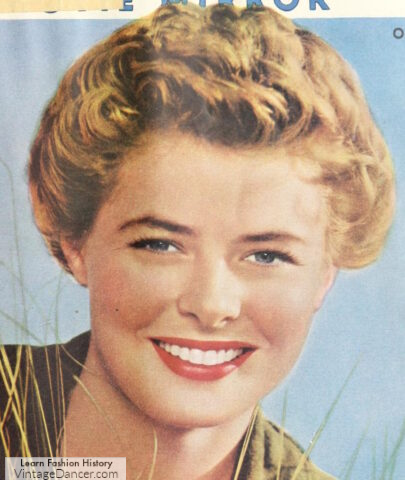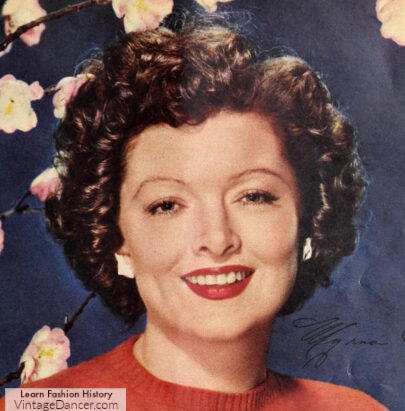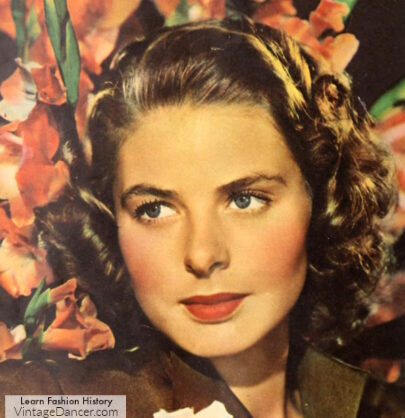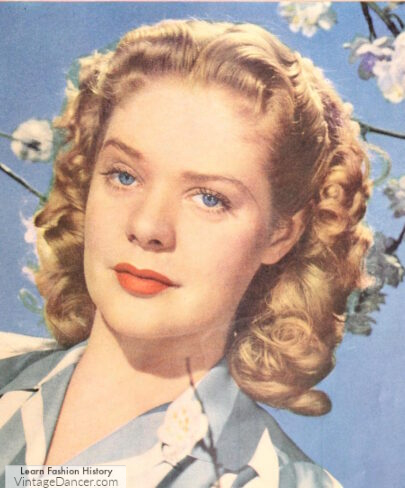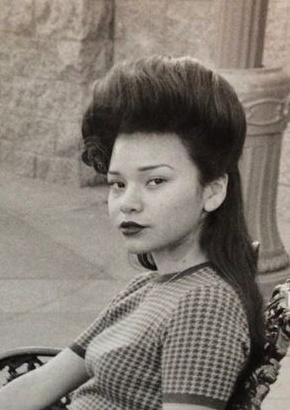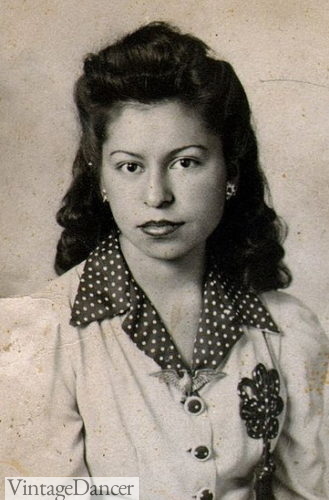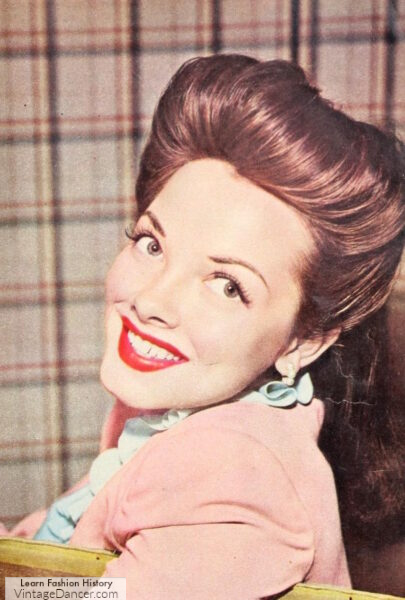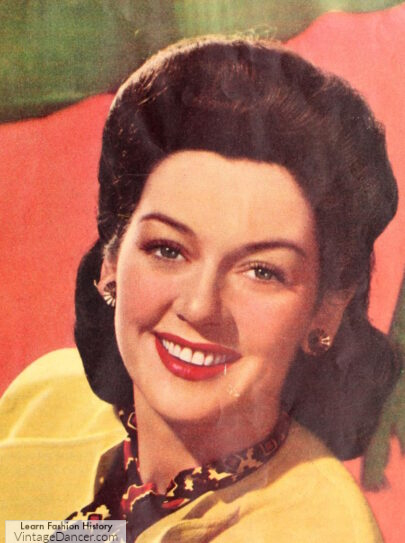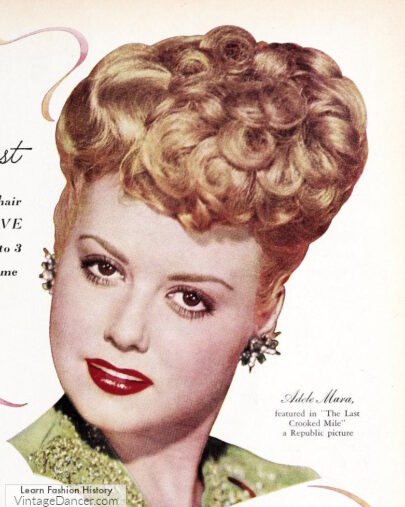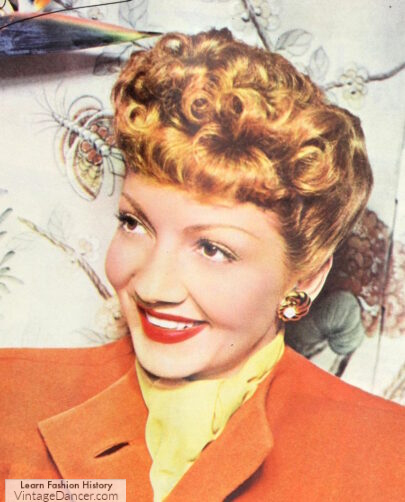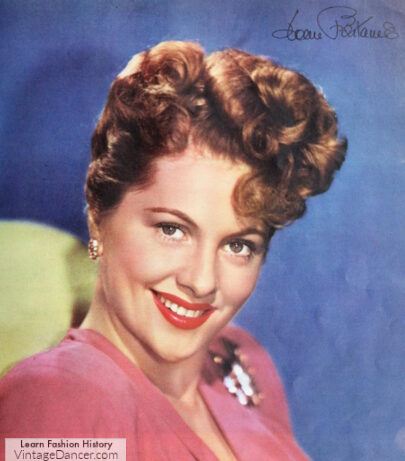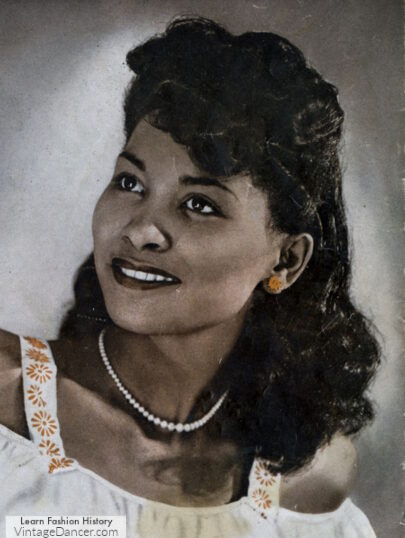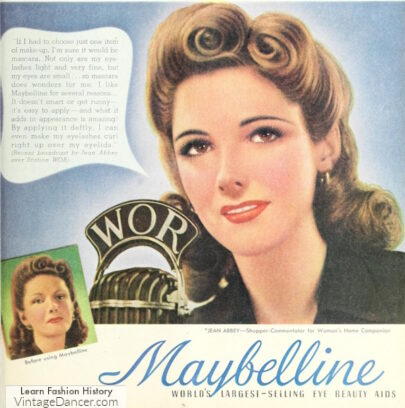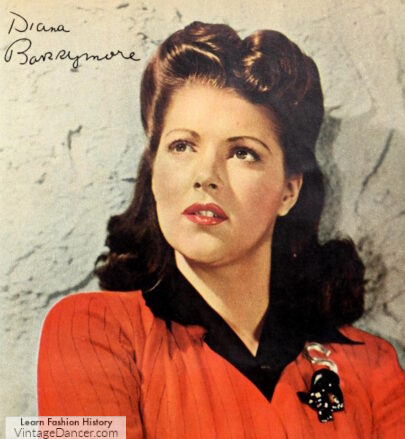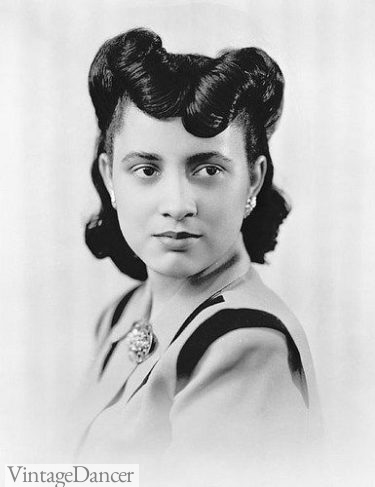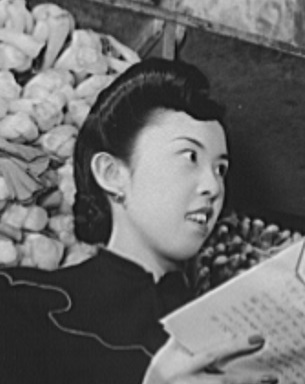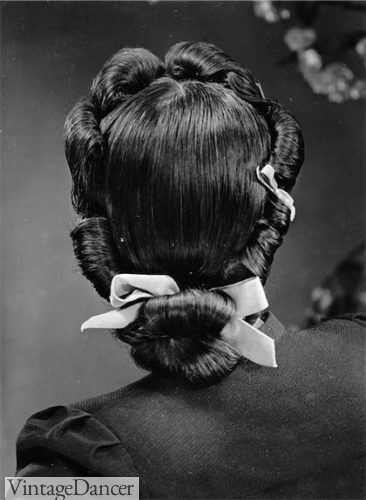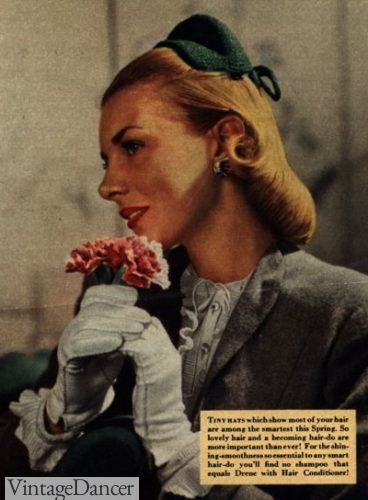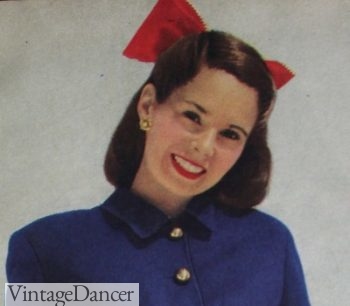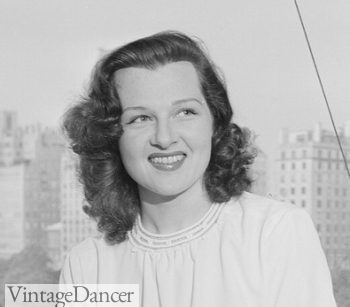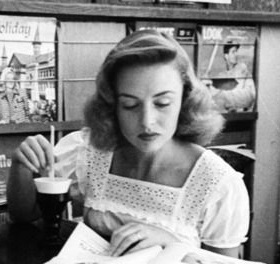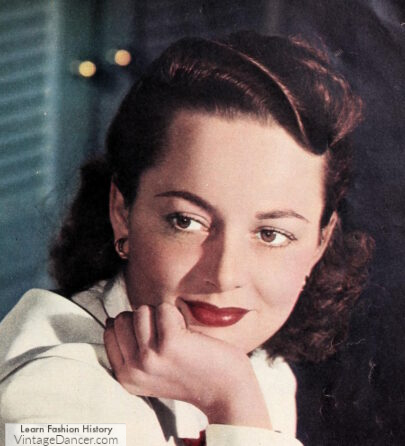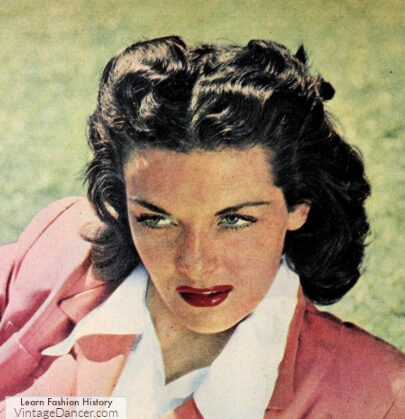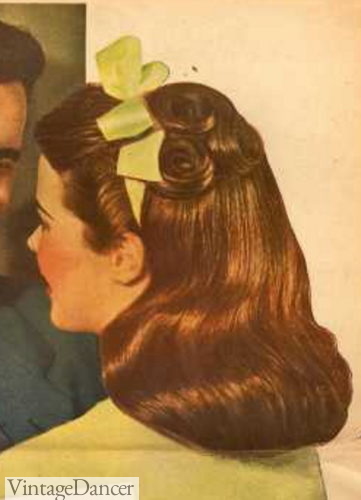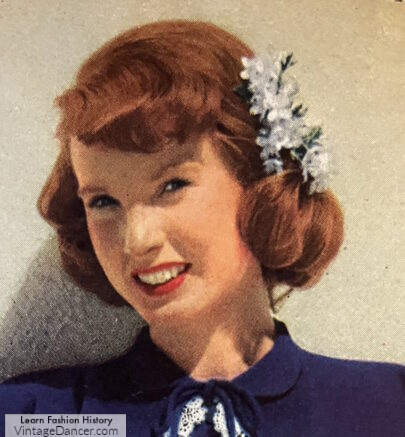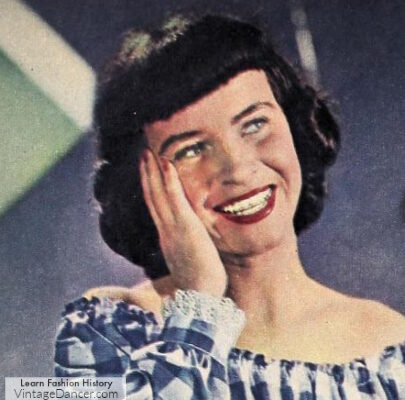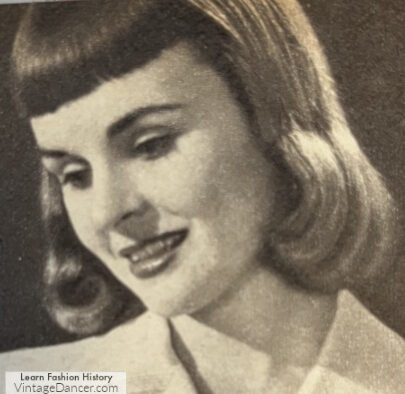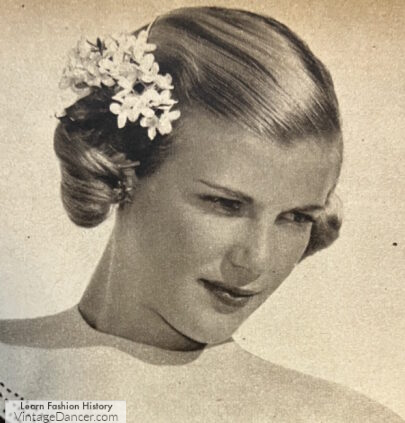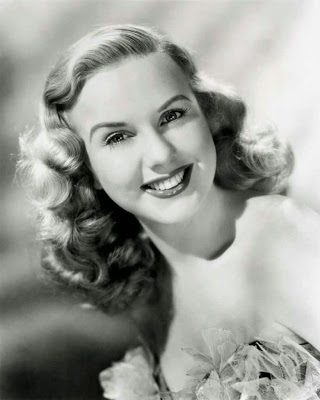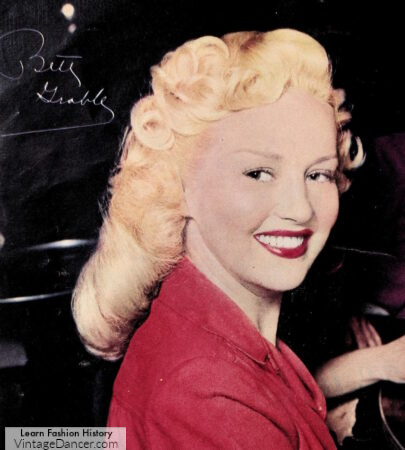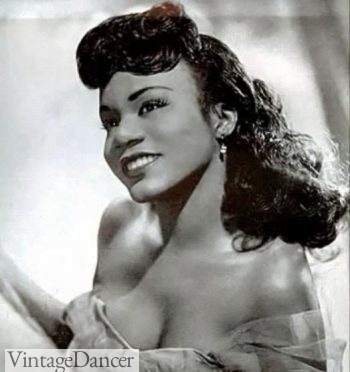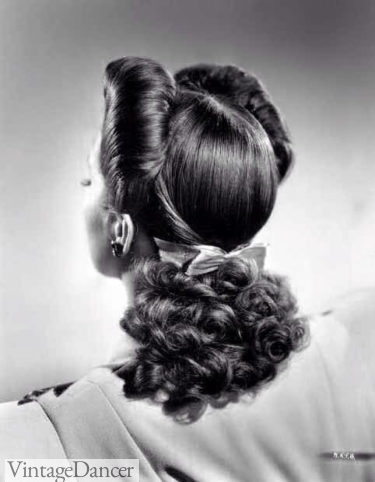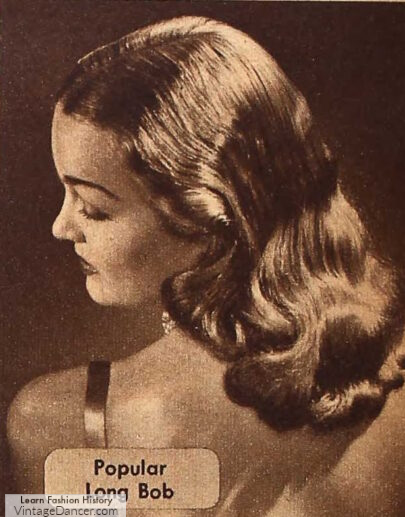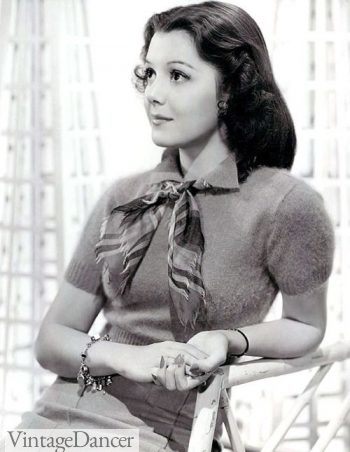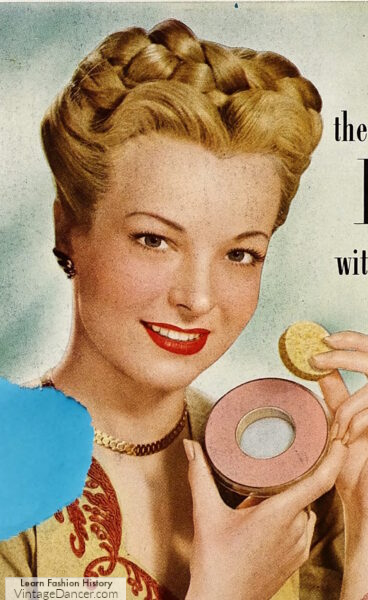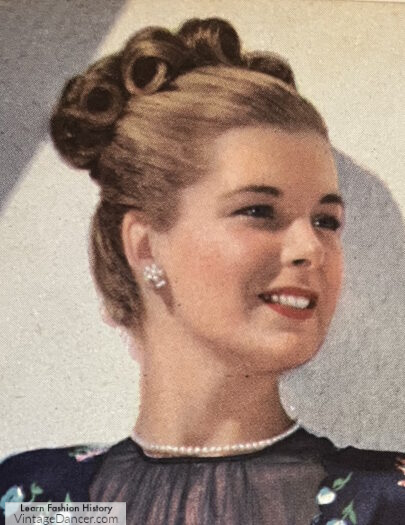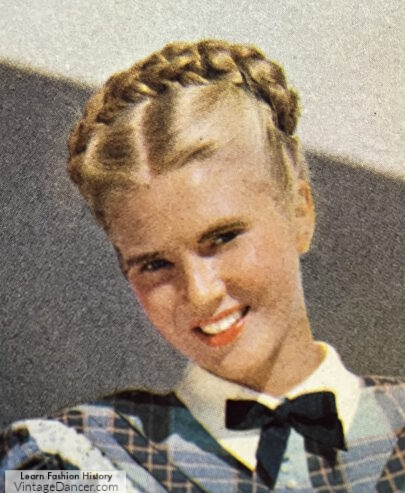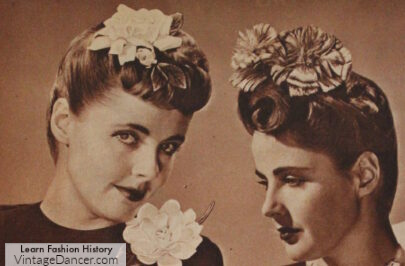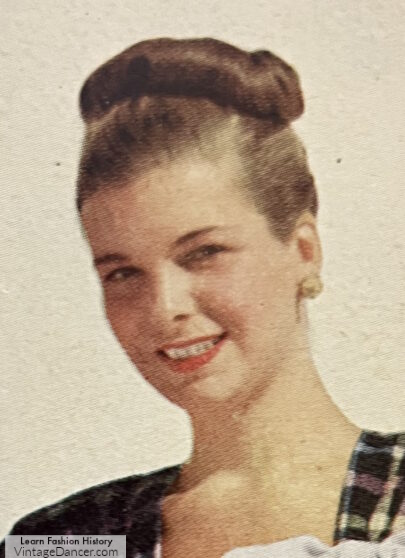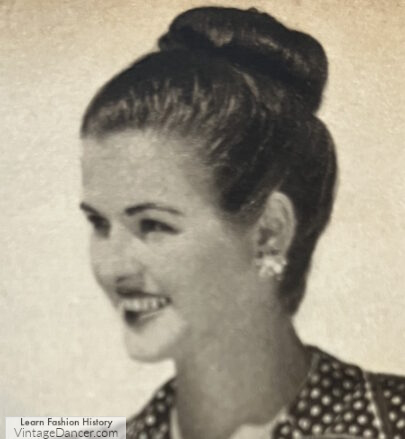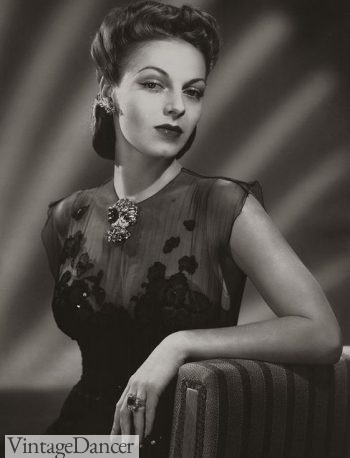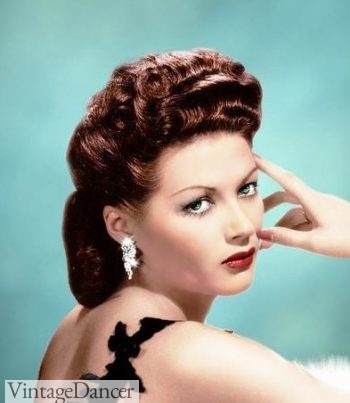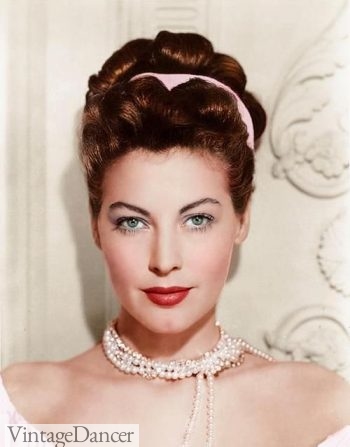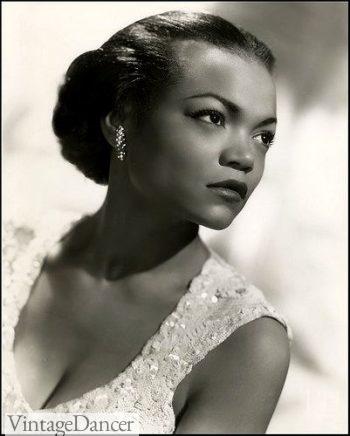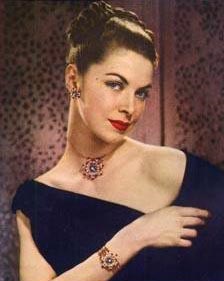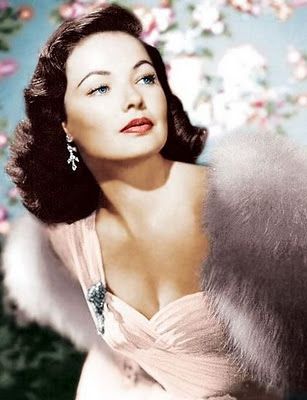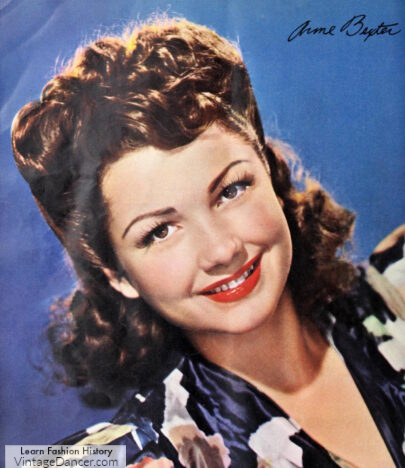
In the ‘40s, women were encouraged to use their hair to ‘fix’ any flaws in their face. If she had perfect, shiny hair with a good color, she should use it to frame her face. If she had a full face, she should use a 1940s hairstyle that piled hair on top of her head to distract from it.
If a thin face was her problem, her hairstyle should be down and over her ears to make it look wider. All of these suggestions contributed to a variety to hairstyles in 1940s.
We also have an article on 1940s men’s hairstyles.
1940s Hair Care
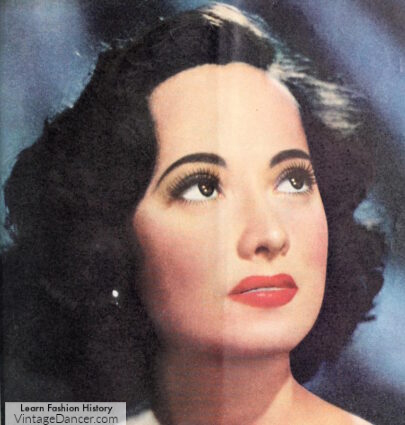
1943 short fluffy curls
It was important to keep women’s 1940s hair clean and shiny, washing it whenever necessary. A woman would also massage her scalp and brush her hair twice a day. When shampoos became scarce and of poor quality, women had to steam their hair over a pot of hot water and then rub the dirt and oil off with a towel.
Hair care was a time consuming task. Most women turned to beauty parlors to get their hair washed, cut, and styled weekly — or as often as she could afford.
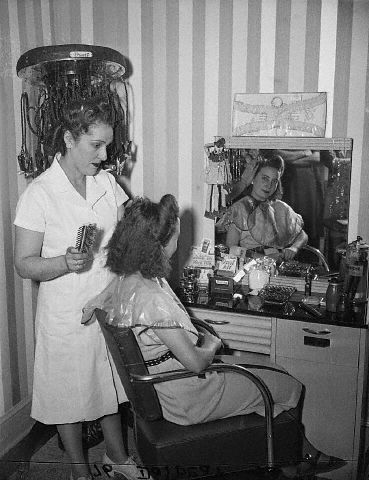
1940s hair salon (permanent wave curl machine in the background)
With so many women in the 1940s going to work in factories and taking time off to get their hair done, factory managers put in their own beauty salons. This reduced the time women were away from work and improved the morale of employees. Beauty was an important duty for women to maintain during the war years especially.
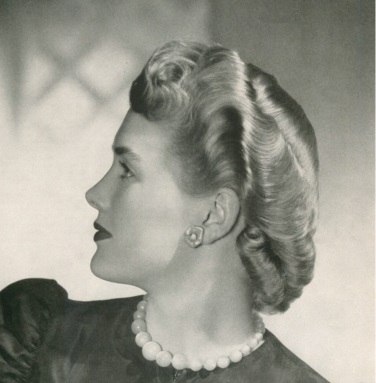
Perfectly styled salon hair, 1943
For time in between beauty appointments, women either wash and styled their hair at home or covered up dirty hair with a scarf, turban, or large hat. There were many creative ways to hide unsightly hair, and 1940s women used them all.
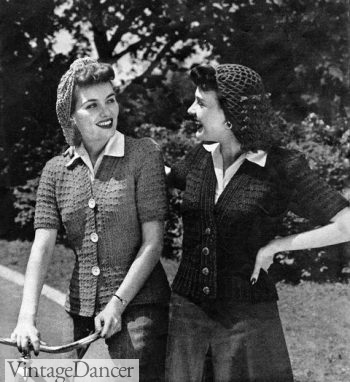
1940s Knit Cardigans & Snoods
1940s Hairstyles
1940s women’s hair was usually worn shoulder-length or a little bit longer, cut in U or horseshoe shape with no bangs. A bit of layering on the ends gave flat hair more volume and helped achieve the curly look needed for most 1940s hairstyles.
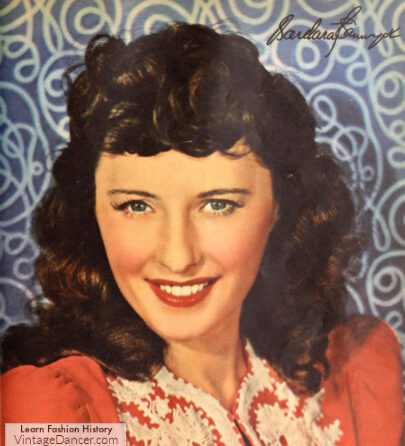
1941 shoulder length curly hairstyle
There were several popular hairstyles during the ’40s, but they all had a few things in common.
First, hairdos were perfectly styled – no messy look.
Second, they were never, ever perfectly straight. Curls and volume were in style, especially above the forehead and on the ends (rolled under). When smooth hairstyle came into fashion in the late 1940s, hair was still curled under and around the face.
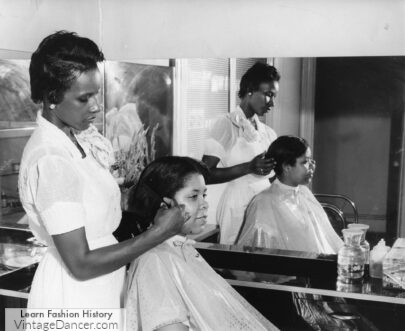
1945 Ru Lo Academy of Hair, learning to cut and style women’s hair
Hairdos almost always started with wet setting pin-curls at night and were styled from there the next morning. Women would follow a pattern curling hair into small circles. The direction of the circle would determine how the hair uncurled when brushed out the next day.
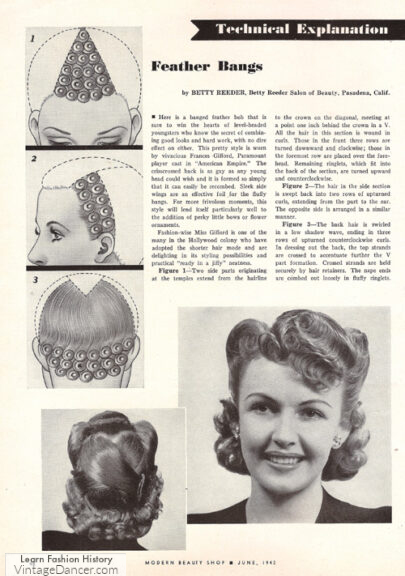
1942 pincurl pattern for “feather bangs”
Early 1940s Hairstyles – WW2
In the first half of the 1940s, hairstyles were rather short with tight ring-curls and some waves forming around the face. Hair from the back of the scalp was pushed to the edges to bring even more volume to the tops and sides. The use of a lot of waves in intricate designs had gone out of favor by the 1942.
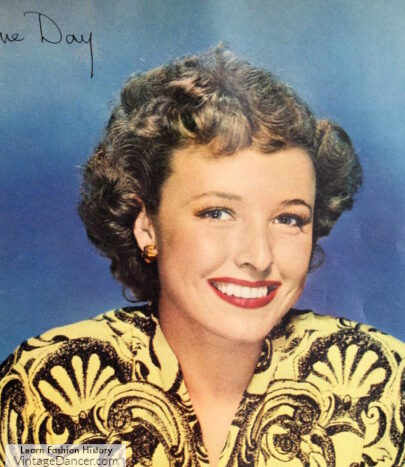
1942 Loraine Days’ short and curly bob
The early 1940s hairstyle look was overall short, practical, and curly, with maybe a wave or two to shape the front. These styles favored small hats and military uniform hats. They looked well on mature women and were easily hidden under turbans when hair became too dirty.
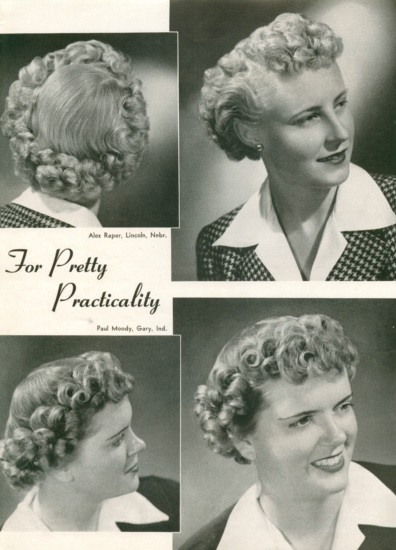
1943- short hair tightly curled and pushed from the back to create a frame around the face
Curly hair could be cut in a full circle, like a halo or longer on top with chin to shoulder length. Side and center parts were common, although subtle.
- 1943 very short curly hairstyle
- 1942 curly short curly hairstyle
- 1941 Curly bob with longer top
- 1941 All long curls held back with bobby pins
1940s mature women’s hairstyles favored long hair (a tradition since their childhood) that was gathered in the back in a low bun. The rest of the hair was waved or curled on top of the head.
The hairstyle looked short since all hair was gathered up away from the face. It was thought that this style kept attention on her face and not on her silver hair.
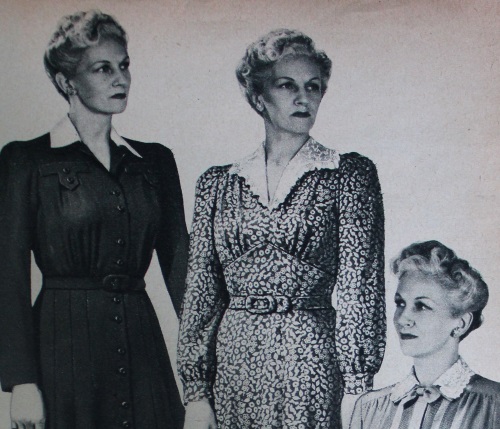
1942-43 Mature women’s hairstyles- long hair gathered up and away from the face.
Alternatively, the short curly bob that was popular in the early 40s was kept by mature women for the duration of the 1940s.
By 1943, the shoulder length cut was preferred by most women. Hair was set in pin curls, then brushed out in the morning. Half the hair was gathered up top and with the ends rolled under to give volume above the forehead (teasing and hair padding helped too). The lower half was sleek and smooth, with ends curled in towards the neck.
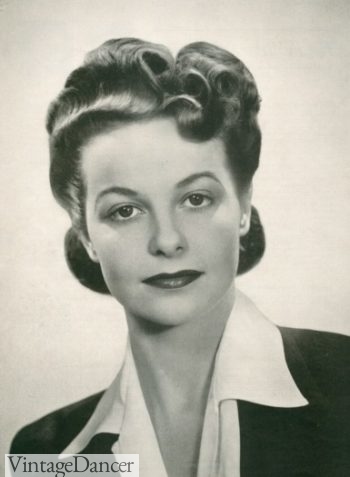
1943, hair gathered and waved with some curls on top, rolled under into a chignon on the bottom
The one-third to half up half down hairstyle dominated the first half of the 1940s. Many women brushed out the curls for a full and fluffy look while others tamed the curl into defined rolls.
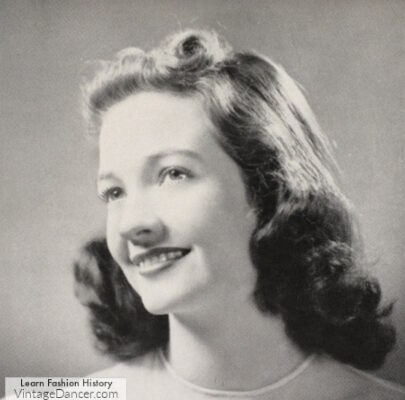
1941 simple one third up shoulder length hairstyle
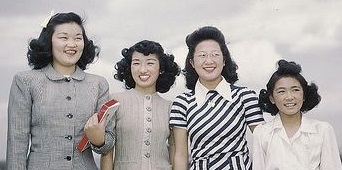
Japanese American woman in internment camps combed and pinned their hair half up and half down varieties.
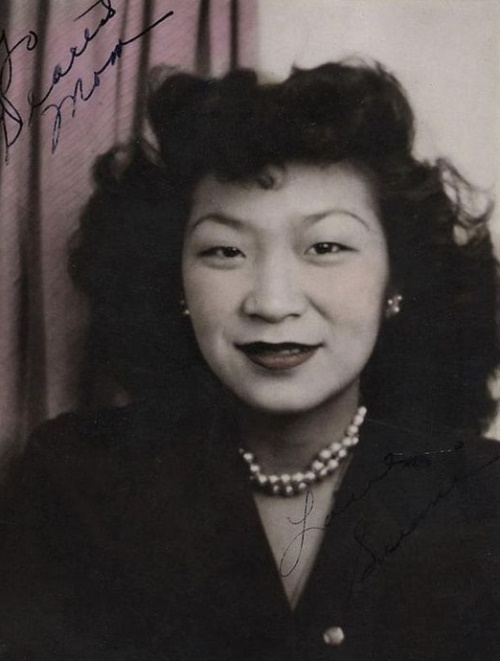
Fluffy curls added volume in the early years.
Many Pachucas, female Zoot Suiters, adopted the half up look, adding even more height to their hair. This, in turn, was called a bouffant style, although ‘bouffant’ also just meant hair gathered on top.
- Bouffant hair for this Pachuca girl
- Small bouffant rolled hair with down curls
- 1943 Katheryn Greyson Bouffant
- 1941 Bouffant Hairstyle
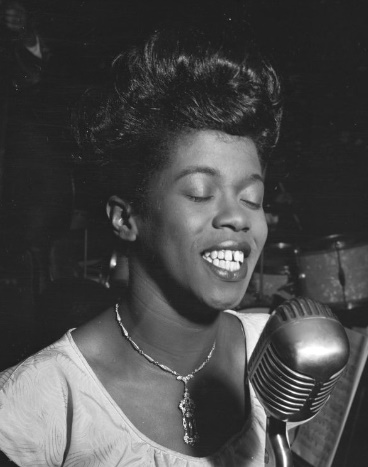
Sarah Vaughn wore a volumeus bouffant/ pompadour for her performances
When the bouffant tipped back over the forehead it became a a pompadour. Hair padding and fake swatches were needed to achieve the volume the pompadour and bouffant required.
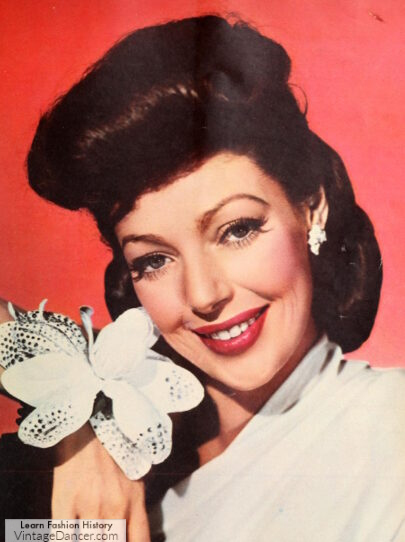
1941 Pompadour hairstyle by Loretta Young
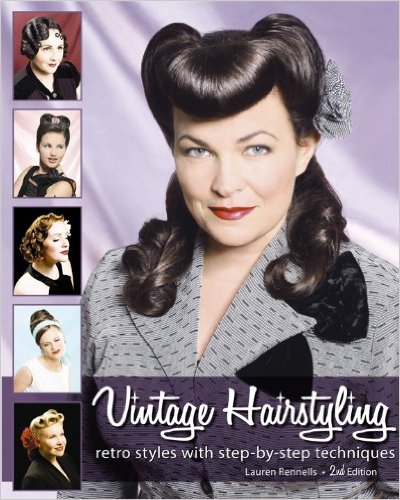
Vintage Hairstyling by Lauren Rennels, showing off a Pompadour style on the cover
The voluminous hair on top was at its peak in 1944. Rita Hayworth sported this new style in Covergirl, with her curly hair creating natural height.
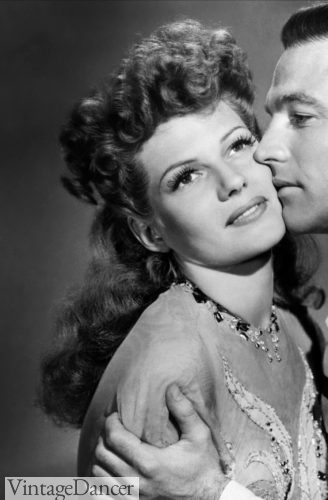
Rita Hayworth in Covergirl, sporting the pompadour or bouffant hairstyle
The curly top bouffant became known as the poodle cut. Half or all hair was gathered up on the top of the crown hanging over the forehead slightly. For some reason red hair became the preferred color for the poodle cut among the movie stars although plenty of blond, brown and black haired ladies wore it too.
- 1946 Adele Mara poodle top hairstyle
- 1943 Claudette Colbert poodle top hairstyle
- 1943 Joan Fontaine poodle top hairstyle
- 1946 Half up poodle or bouffant
1940s Victory Rolls Hairstyle
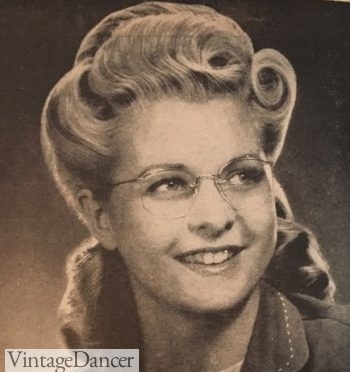
1942 half up half down hair Victory rolls on both sides (the R roll exposes the ring while the Left is hidden behind the waved bangs.)
Another technique to gather hair up high was to roll the sides around two fingers and pin them in place, roll and all. This was a technique coined Victory rolls and is probably the most iconic of all 1940s hairstyles today.
- 1941 double Victory Rolls
- 1942 Double Victory Rolls
The Victory Roll were not easy to achieve, at least in a style that lasted all day. Looking at vintage photos of “real women,” the Victory roll was saved for salon styled days.
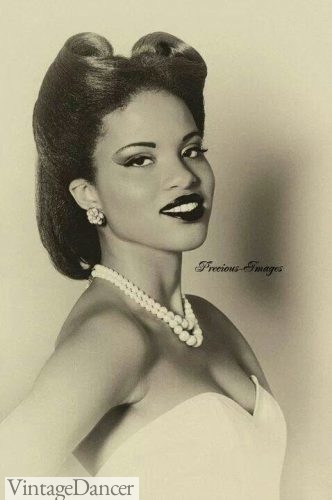
Double Victory roll
1940s Victory rolls could be single but usually double with one on each side of the head. They could also be rolled to the very top of the head. If left on the side, the top of the hair was styled with equal fullness. The bottom was left down and rolled inward towards the neck, or gathered in a low bun or chignon if the hair was long.
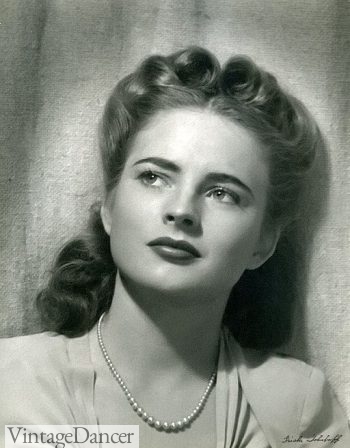
Coleen Gray wearing double Victory rolls on top
1940s hair roll variations included bumper bands, Gibson rolls, sausage rolls and others. Rolls were easier to style without trying to achieve the open Victory curl at the top.
Rolls could be gather on either side on the head or from under the head (Gibson.) Small rolls all over the head were used by women with short hair and arranged in a very artful way.
- Double rolls from the front
- Long rolls from back to top
- Several rolls circle the head ending in a rolled bun with bow
- 1946 the Gibson roll/tuck moved to the bottom of the neck
Mid to Late 1940s Hairstyles
By 1945, women’s hair came back down off the top of the head. In fact, the opposite was now popular. Completely smooth hair on top with rolled medium long-hair from just above the ears down.
The top hair could be pulled completely back or with a side part. Many women continued to have some Victory rolls or other top and side volume, but it was not as grand as the earlier years. Simple was in. Easy was in. These styles accomplished both.
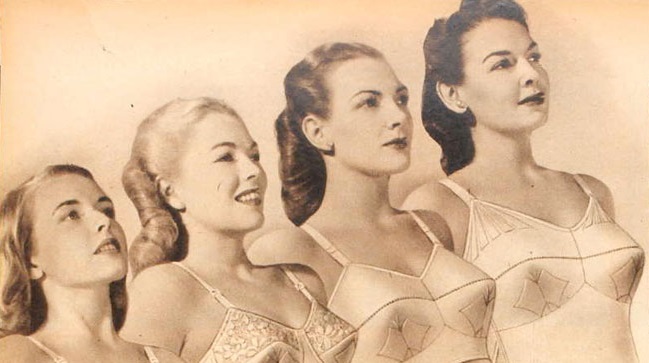
1945- smooth top with full rolled longer bottom
- 1948 – Smooth hair still pulled back, but now with minimal curl
- Jo Stafford, 1946, side waves
- 1946, Donna Reed sports a deep side part with fluffy neck curls
- 1948 Half up was still in style, but now smooter
- 1946 curls were brushed down to smooth the top
- 1947 headband bow long hair
The rest of the decade embraced easy hairstyles. Tops were smooth, waved, or flat. Sides and the bottom were full. Hair was often parted deep to one side or down the middle, and longer hair could either be rolled or left in a naturally curvy/wavy state.
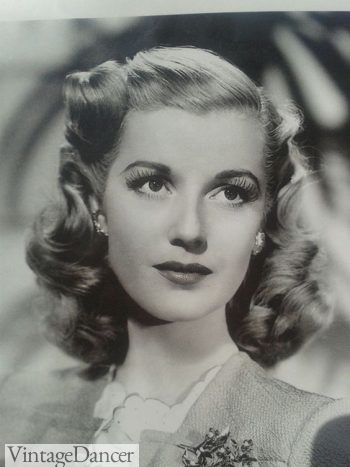
Mid 40s hairstyle with soft curls framing the neck
By 1948, young women’s hair shortened up again to a shoulder or chin length bob. Curl was less significant and volume minimal. Short bangs or fringe made a reappearance too.
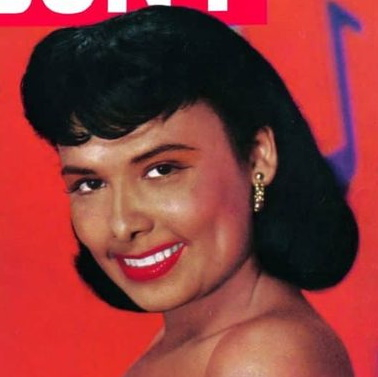
Lena Horne, 1946
- 1948 Short hair with side swept bangs
- 1948 short black hair with bangs
- 1948 short hair with short bangs
- 1948 short bob
1940s Long Hairstyles
Younger women or those who favored longer hairstyles chose a basic combed curl set, or opted for a deep part to one side/center with hair pinned back past the temples. This was easy and youthful. It could be easily achieved at home without the aid of a beauty parlor.
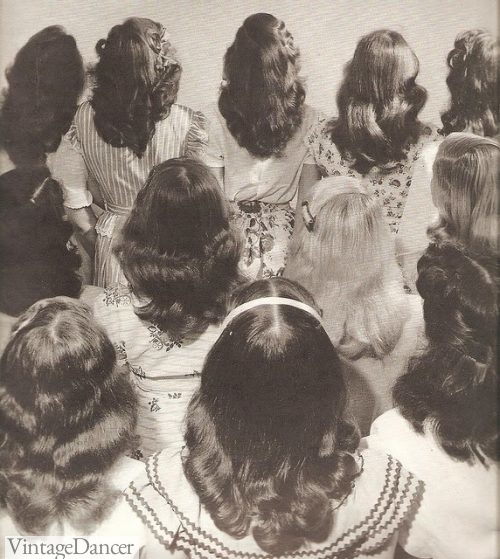
Young teen and women’s long hair with a simple center part.
Silver screen stars also favored long hair, which probably inspired young women to keep their hair long. Veronica Lake, Hedy Lamar, Gene Tierney, Lauren Bacall, and Rita Hayworth were just a few stars who had amazing long locks. Most were full of curl or natural wave, but others, like Ms. Lake, made sleek hair sexy during the era that favored volume.
- Deanna Durbin, 1940, soft big curls
- 1945 Betty Grable’s longy and curly hairstyles
- Long curly African-American hair
- Double rolls on the sides and a big ponytail of curls with bow
- 1945 long and smooth with rolled edges
- Center part and long loose waves
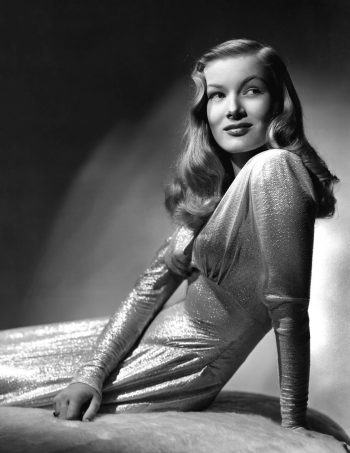
Veronica Lake had the sexiest long hair
More and more women started to wear their long hair in an updo during the day. Long hair was braided into a crown, many rolls into a pile that mimicked curls, or swept up into a large victory roll. A large wide and semi flat bun was another easy daytime updo.
A pretty flower accented many updos. These polished looks would became an iconic hairstyle of the 1950s.
- 1947 braided crown
- 1948 Pincurl bun
- 1948 braided crown aka milkmaid braids
- 1944 updo with flowers
- 1948 High and wide bun
- 1948 high bun
1940s Evening Hair Styles
In the 1940s evening, hair was gathered up and off the face and neck. In the early years, hair was piled high on the crown, just like daytime looks. It could also be rolled in one or several buns or braids for a sleek look. And if a woman had beautiful long hair, by all means, she could wear it down as well.
See more examples of 1940s evening hairstyles.
- Gathered up with some down in a tight curl
- Volume on top, rolled to the back
- All up in a ball of curls
- Eartha Kitt, Sleek back with a large chigon
- Sleek back into a braided bun on top
- All loose and wavy
1940s Hair Accessories
Learn about 1940s hair flowers, bows, clips, combs and turbans to accessorize your 1940s hairstyles. Read it here.
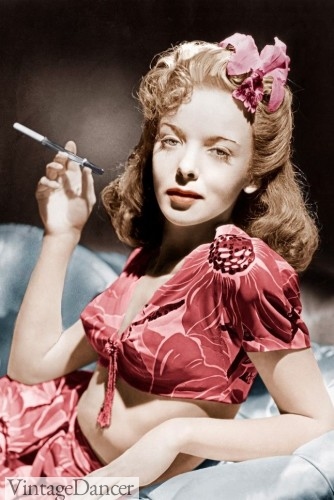
Snoods or hair nets were another iconic 1940s hair accessory, especially during WW2. Read and history and see many examples of 1940s snoods.
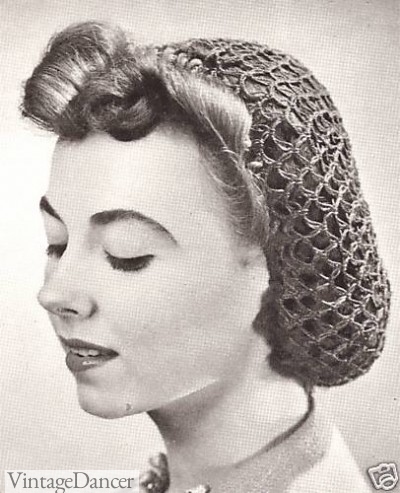
Simple Knit Snood
Styling Your 1940s Hair
There are many good tutorials, guides, and tips to 1940s hairstyles online. I am not going to attempt to add my own thoughts (I’m really not very good with hair) but I do want to point you in the direction to what I believe are the best tutorials.
Begin with this article on easy vintage hairstyles. We all need to start with the basics that look good and still work with a modern haircut.
Begin with creating Pin Curls:
- Lisa Freemont Street’s Guide to Pin Curls Part One (Video)
- Lisa Freemont Street’s Guide to Pin Curls Part Two – (Video – this details the importance of the brushing out process)
- Emi’s Vintage – Pincurls and brushing videos for women of color
Make a simple side part- fast and easy for most hair lengths
- Easy 1940s Hair Roll (Video) by The Boyer Sisters
Add Victory Rolls ( a must for the 1940s! )
- Victory Roll Hair Tutorial – Cherry Dollface
A back roll does not require pin curls and is easy to do with medium length hair.
- How to do a Vintage Back Roll Using a Scarf – By Gum, By Golly
- 1940s Bumper Bangs – If you have short hair try this one
- Pin up with faux Bangs for Kinky Hair (Video)- ThePinupNoire
- Gibson Tuck – An easy day style for medium or long hair
The poodle, is a great style for naturally curly medium to long hair. I have done it when I had long hair and it was easy and beautiful.
- Betty Grable Pin Up Poodle – Miss Rockabilly Ruby (Video)
- Rolls and pins for naturally curly hair – Amber Rose Theron
Braids
-
- Milkmaid braids – Emi’s Vintage
- Braids for long hair – Fitfully Vintage
When you don’t want to style your hair or need a Rosie the Riveter look try a head scarf or turban
- So Apparently I like Turbans, tutorial – Lauren Rennells
- How to Tie a Turban – British Pathe (1942 Video)
- Vintage Head Scarf Tutorial – Chatterblossom
Debbie Sessions has been teaching fashion history and helping people dress for vintage themed events since 2009. She has turned a hobby into VintageDancer.com with hundreds of well researched articles and hand picked links to vintage inspired clothing online. She aims to make dressing accurately (or not) an affordable option for all. Oh, and she dances too.
